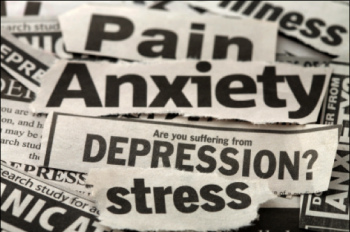By Katherine Gibson (The Cascade) – Email
Print Edition: Online only
After having one session with UFV’s counseling staff and learning about the importance of proper breathing, Gabriella has returned for a second session. Building on the physical principles taught to her the week before, this session focused more acutely on how to break down the thought processes that lead individuals to feel anxiety and self-doubt.
As Gabriella explains, during her second session, UFV’s counselling staff made use of two worksheets – one defining self-defeating thoughts and the other systematically breaking down heightened situations of stress.
“I have little handout sheets that [the counsellor] gave me. One has a checklist of self-defeating or twisted thoughts – that’s what they call them. They are the thoughts that we tell ourselves – the thoughts that aren’t true,” she explains.
“My worries are more self-defeating – like ‘I’m not good enough’ – that sort of stuff. [The checklist] has our fears and our self-defeating beliefs and the things that we do, maybe not consciously,” Gabriella continues, “like over-exaggerating something when it’s actually not that big of a deal.”
After spending time pinpointing her own self-defeating beliefs, Gabriella was introduced to a log system. This worksheet, which provides a place for students to thoroughly break down their thought patterns and emotions, is a tool that Gabriella sees value in.
“We went through – and [they] had a little log. If I get into an upsetting event I’m supposed to go through and recognize the emotions that led me there and how I am feeling in that moment,” Gabriella notes. “And then using the log to check in with myself and bringing the situation back down to Earth.”
For Gabriella, one situation that has proven to be especially upsetting is a recent break-up. Although physically removed from the situation, Gabriella still struggles with the emotions related to this event.
“My main issue, which I think a lot of people go through, is that I went through a break-up. It wasn’t just an average kind of normal break-up, either,” she explains. “Like I said before, I was in England, and it was the whole long-distance thing, and then he met someone else – there was no clear, clean break.
“That whole situation got a little bit twisted and that’s when my own twisted thoughts came in,” she goes on. “I’m still dealing with it, but I’m getting over it a little bit more. I’m working through it. I used the worksheet to basically write down the whole situation and how I was feeling.”
By using the worksheet, Gabriella was able to pinpoint a specific event related to her break up that caused an intensified sense of self-doubt.
“He put stuff online with pictures of him and his new girlfriend and other things that were similar. That’s the thing with being online, you’re constantly in touch with everybody,” Gabriella notes. “There’s a curiosity that we have, and I don’t know why we do it – but we just want to know.
“There was this blog post from him that popped up, and I was thinking, ‘okay. I’m interested. So I clicked it and—boom—in my face were pictures of them together and him talking about her being his future wife,” she continues. “I immediately went, ‘why did I just do that to myself?’
“I wrote all of my emotions down – and that is where the worksheet comes in. It’s just recognizing and slowing it down. What we do is we rush in and we go into a frenzy,” she goes on. “These worksheets are about recognizing those moments so we don’t go over the edge. Or if we do go over, we’re more in touch with the emotions we’re feeling and why we’re feeling them. We’re more in control, rather than everything just exploding.”
After using the worksheet to break down the situation and the emotions she was feeling, Gabriella was encouraged to recognize the role her own self-defeating thoughts played in the event.
“I went through and acknowledged that I was feeling rejection, the sort of natural feelings that come with seeing that,” she says. “But then there’s also the feeling that ‘I should have moved on,’ or, ‘I should be over this already.’”
Having broken down the event and recognized her own self-defeating thoughts, Gabriella was asked to write down a response to how she was feeling.
“You write out what you think you’re feeling and then you have to come up with a response for it. My response to this was: ‘Even though I want to have moved on, I haven’t – and that’s the truth,” Gabriella explains. “The truth statement stops distorting everything. And it did help. The thing is, we get sucked up in this cyclone of everything around us. This is about taking two seconds to stop, reflect, and just understand where you are in that moment.”
Although this was a positive experience, Gabriella still acknowledges that rehashing painful events, such as her break-up, are emotionally painful. However, she maintains the importance of properly understanding the ways in which we can deal with the upsetting situations we are faced with.
“I’ll be honest … I did cry a little bit. It was a release. It can be tough to bring up those feelings again, but if you’re not bringing them up, you’re just sitting with them, and that’s where things fester, pile up, and sandwich into one big crazy mess,” she notes.
“When you do this sort of thing, it makes you feel more normal. You’re being okay with yourself a little more. It’s looking at how you’re feeling on paper and realizing ‘I can work with this,’” Gabriella concludes. “It’s just adding that awareness and realizing that these feelings are something that everybody shares. It’s realizing that you’re not alone. Overall, this process is going well; I’m still not the master yet, but it’s just about taking one step at a time.”


